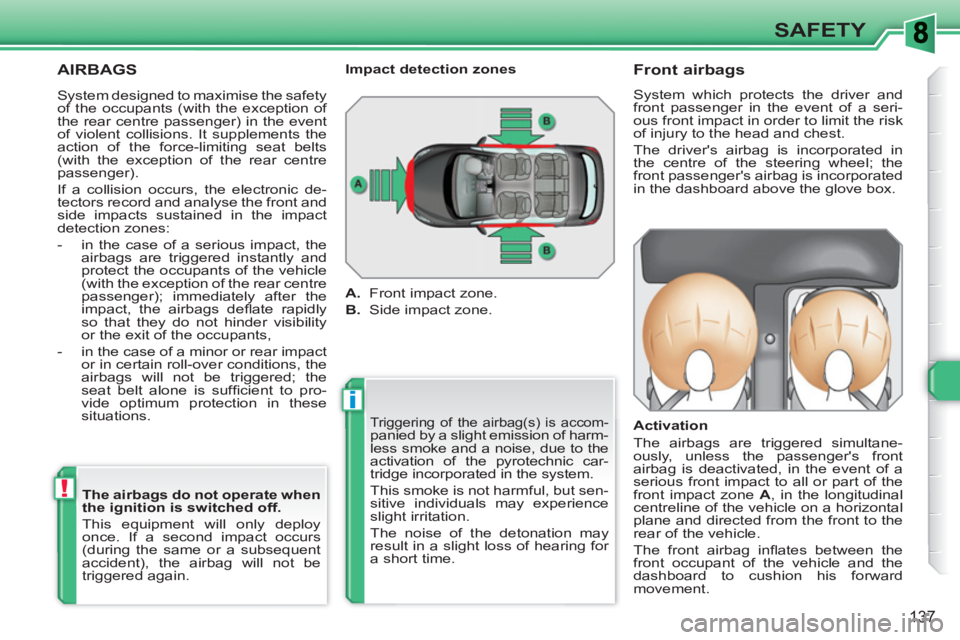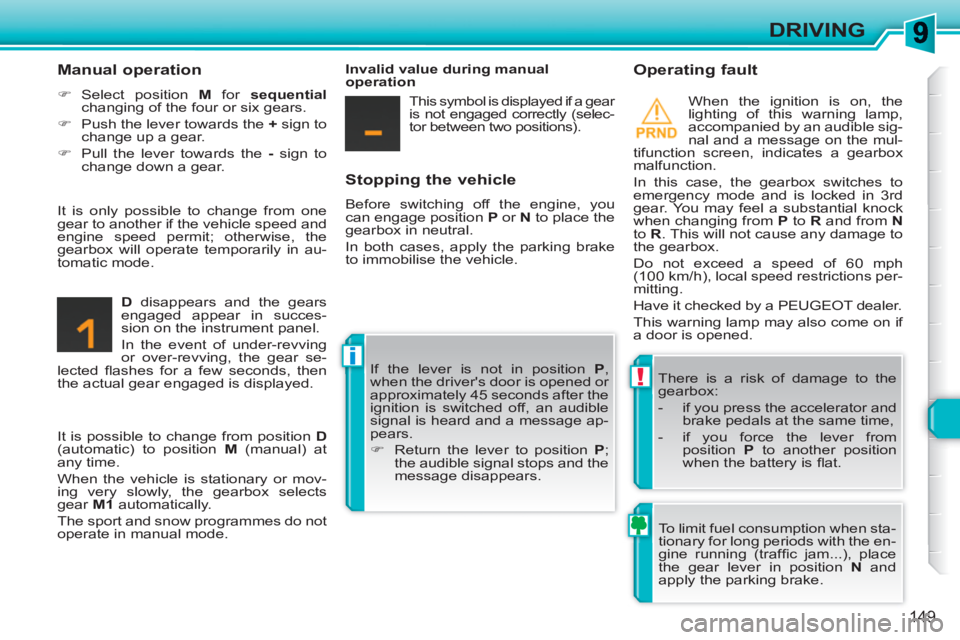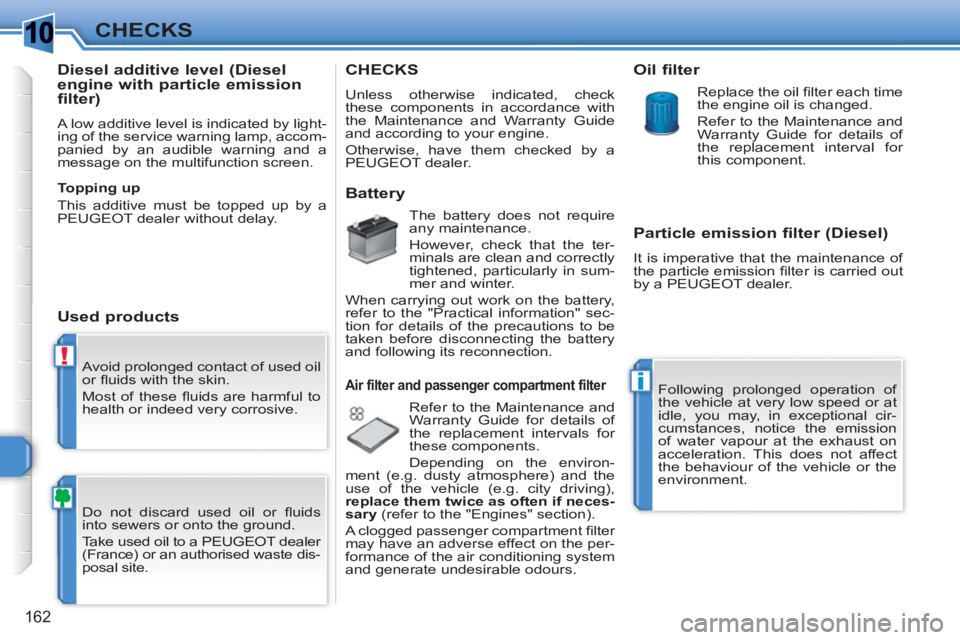2010 PEUGEOT 308 SW BL light
[x] Cancel search: lightPage 139 of 336

i
!
137
SAFETY
AIRBAGS
Triggering of the airbag(s) is accom-panied by a slight emission of harm-
less smoke and a noise, due to the
activation of the pyrotechnic car-
tridge incorporated in the system.
This smoke is not harmful, but sen-
sitive individuals may experience
slight irritation.
The noise of the detonation may
result in a slight loss of hearing for
a short time.
Front airbags
System which protects the driver and
front passenger in the event of a seri-
ous front impact in order to limit the risk
of injury to the head and chest.
The driver's airbag is incorporated in
the centre of the steering wheel; the
front passenger's airbag is incorporated
in the dashboard above the glove box.
Activation
The airbags are triggered simultane-
ously, unless the passenger's front
airbag is deactivated, in the event of a
serious front impact to all or part of the
front impact zone A
, in the longitudinal
centreline of the vehicle on a horizontal
plane and directed from the front to the
rear of the vehicle.
The front airbag infl ates between the
front occupant of the vehicle and the
dashboard to cushion his forward
movement.
Impact detection zones
A.
Front impact zone.
B.
Side impact zone.
The airbags do not operate when
the ignition is switched off.
This equipment will only deploy
once. If a second impact occurs
(during the same or a subsequent
accident), the airbag will not be
triggered again.
System designed to maximise the safety
of the occupants (with the exception of
the rear centre passenger) in the event
of violent collisions. It supplements the
action of the force-limiting seat belts
(with the exception of the rear centre
passenger).
If a collision occurs, the electronic de-
tectors record and analyse the front and
side impacts sustained in the impact
detection zones:
- in the case of a serious impact, the
airbags are triggered instantly and
protect the occupants of the vehicle
(with the exception of the rear centre
passenger); immediately after the
impact, the airbags defl ate rapidly
so that they do not hinder visibility
or the exit of the occupants,
- in the case of a minor or rear impact
or in certain roll-over conditions, the
airbags will not be triggered; the
seat belt alone is suffi cient to pro-
vide optimum protection in these
situations.
Page 151 of 336

!
i
149
DRIVING
Stopping the vehicle
Before switching off the engine, you
can engage position P
or N
to place the
gearbox in neutral.
In both cases, apply the parking brake
to immobilise the vehicle.
Operating fault
When the ignition is on, the
lighting of this warning lamp,
accompanied by an audible sig-
nal and a message on the mul-
tifunction screen, indicates a gearbox
malfunction.
In this case, the gearbox switches to
emergency mode and is locked in 3rd
gear. You may feel a substantial knock
when changing from P
to R
and from N
to R
. This will not cause any damage to
the gearbox.
Do not exceed a speed of 60 mph
(100 km/h), local speed restrictions per-
mitting.
Have it checked by a PEUGEOT dealer.
This warning lamp may also come on if
a door is opened.
There is a risk of damage to the
gearbox:
- if you press the accelerator and
brake pedals at the same time,
- if you force the lever from
position P
to another position
when the battery is fl at.
Manual operation
�)
Select position M
for sequential
changing of the four or six gears.
�)
Push the lever towards the +
sign to
change up a gear.
�)
Pull the lever towards the -
sign to
change down a gear.
D
disappears and the gears
engaged appear in succes-
sion on the instrument panel.
In the event of under-revving
or over-revving, the gear se-
lected fl ashes for a few seconds, then
the actual gear engaged is displayed. If the lever is not in position P
,
when the driver's door is opened or
approximately 45 seconds after the
ignition is switched off, an audible
signal is heard and a message ap-
pears.
�)
Return the lever to position P
;
the audible signal stops and the
message disappears.
It is only possible to change from one
gear to another if the vehicle speed and
engine speed permit; otherwise, the
gearbox will operate temporarily in au-
tomatic mode.
Invalid value during manual
operation
This symbol is displayed if a gear
is not engaged correctly (selec-
tor between two positions).
It is possible to change from position D
(automatic) to position M
(manual) at
any time.
When the vehicle is stationary or mov-
ing very slowly, the gearbox selects
gear M1
automatically.
The sport and snow programmes do not
operate in manual mode. To limit fuel consumption when sta-
tionary for long periods with the en-
gine running (traffi c jam...), place
the gear lever in position N
and
apply the parking brake.
Page 164 of 336

1
!
i
162
CHECKS
Avoid prolonged contact of used oil
or fl uids with the skin.
Most of these fl uids are harmful to
health or indeed very corrosive.
Do not discard used oil or fl uids
into sewers or onto the ground.
Take used oil to a PEUGEOT dealer
(France) or an authorised waste dis-
posal site.
Diesel additive level (Diesel
engine with particle emission
filter)
A low additive level is indicated by light-
ing of the service warning lamp, accom-
panied by an audible warning and a
message on the multifunction screen.
Used products
CHECKS
Unless otherwise indicated, check
these components in accordance with
the Maintenance and Warranty Guide
and according to your engine.
Otherwise, have them checked by a
PEUGEOT dealer.
Battery
The battery does not require
any maintenance.
However, check that the ter-
minals are clean and correctly
tightened, particularly in sum-
mer and winter.
When carrying out work on the battery,
refer to the "Practical information" sec-
tion for details of the precautions to be
taken before disconnecting the battery
and following its reconnection.
Air filter and passenger compartment filter
Refer to the Maintenance and
Warranty Guide for details of
the replacement intervals for
these components.
Depending on the environ-
ment (e.g. dusty atmosphere) and the
use of the vehicle (e.g. city driving),
replace them twice as often if neces-
sary
(refer to the "Engines" section).
A clogged passenger compartment fi lter
may have an adverse effect on the per-
formance of the air conditioning system
and generate undesirable odours.
Particle emission filter (Diesel)
It is imperative that the maintenance of
the particle emission fi lter is carried out
by a PEUGEOT dealer.
Oil filter
Replace the oil fi lter each time
the engine oil is changed.
Refer to the Maintenance and
Warranty Guide for details of
the replacement interval for
this component.
Following prolonged operation of
the vehicle at very low speed or at
idle, you may, in exceptional cir-
cumstances, notice the emission
of water vapour at the exhaust on
acceleration. This does not affect
the behaviour of the vehicle or the
environment.
Topping up
This additive must be topped up by a
PEUGEOT dealer without delay.
Page 190 of 336

1
188
PRACTICAL INFORMATION
Fuse N°
Rating
Functions
G36
30 A
Driver and passenger heated seats.
G37
5 A
Driving position memory unit, lighting rheostat.
G38
30 A
Driver’s seat memory unit.
G39
30 A
Trailer fusebox supply.
G40
-
Not used.
Fuse N°
Rating
Functions
F12
15 A
Instrument panel, seat belt and passenger’s front
airbag warning lamps display, air conditioning,
driver’s seat memory unit, 2nd row rear seat
switches, driving school module.
F13
5 A
Engine fusebox, airbags, electronic gear control
gearbox gear lever, trailer fusebox.
F14
15 A
Multifunction screen, amplifi er, Bluetooth system,
rain/brightness sensor, parking sensors control
unit.
F15
30 A
Locking and deadlocking.
F17
40 A
Rear screen and door mirrors defrosting.
SH
-
PARC shunt.
Page 199 of 336

1
i
i
!
197
PRACTICAL INFORMATION
TOWING A TRAILER,A CARAVAN, ETC.
Your vehicle is primarily designed for
transporting people and luggage, but it
may also be used for towing a trailer.
Driving advice
As the fan is electrically controlled, its
cooling capacity is not dependent on
the engine speed.
�)
To lower the engine speed, reduce
your speed.
The maximum towing load on a long
slope depends on the gradient and the
ambient temperature.
In all cases, pay attention to the coolant
temperature.
Side wind
�)
Take into account the increased
sensitivity to side wind.
Cooling
Towing a trailer on a slope increases
the temperature of the coolant.
Braking
Towing a trailer increases the braking
distance.
Tyres
�)
Check the tyre pressures of the towing
vehicle and of the trailer, observing the
recommended pressures.
Lighting
�)
Check the electrical lighting and
signalling on the trailer.
The rear parking sensors will be de-
activated automatically if a genuine
PEUGEOT towbar is used.
�)
If the warning lamp and the
STOP
warning lamp come
on, stop the vehicle and
switch off the engine as
soon as possible.
Towbar suitable for the attachment of a
trailer or caravan with additional lighting
and signalling.
Distribution of loads
�)
Distribute the load in the trailer so
that the heaviest items are as close
as possible to the axle and the nose
weight approaches the maximum
permitted without exceeding it.
Air density decreases with altitude, thus
reducing engine performance. Above
1 000 metres, the maximum towing load
must be reduced by 10 % and so on for
every 1 000 metres of altitude.
Refer to the "Technical Data" section for
details of the weights and towing loads
which apply to your vehicle. Driving with a trailer subjects the towing
vehicle to more signifi cant stress and its
driver must be particularly careful.
We recommend the use of genuine
PEUGEOT towbars and their har-
nesses that have been tested and
approved from the design stage
of your vehicle, and that the fi t-
ting of the towbar is entrusted to a
PEUGEOT dealer.
If the trailer is not fi tted by a
PEUGEOT dealer, it is imperative
that it is fi tted using the electrical
pre-equipment installed at the rear
of the vehicle, in accordance with
the manufacturer's instructions.
If your vehicle is fi tted with the
1.6 THP 200 hp engine, you can-
not fi t a towbar. The space occu-
pied by the sport exhaust system
prevents this.
Page 207 of 336

1
205
TECHNICAL DATA
The GTW and towed load values indicated are valid up to a maximum altitude of 1 000 metres; the towed load mentioned
must be reduced by 10 % for each additional 1 000 metres of altitude.
The speed of a towing vehicle must not exceed 60 mph (100 km/h) (comply with the legislation in force in your country).
High ambient temperatures may result in a reduction in the performance of the vehicle to protect the engine; if the ambient
temperature is above 37 °C, limit the towed load.
WEIGHTS AND TOWED LOADS (in kg)
Petrol engines
1.4 litre VTi 16V
95 hp
1.4 litre VTi 16V
98 hp
1.6 litre VTi 16V 120 hp
Gearboxes
Manual
Manual
Manual
Auto.
Model codes:
4C...
8FS-C
8FR-0
5FW-C
5FS-0
5FW-F
5FS-9
- Unladen weight
1 271
1 271
1 287
1 287
1 312
1 312
- Kerb weight
1 346
1 346
1 362
1 362
1 387
1 387
- Payload
489
509
528
528
512
523
- Gross vehicle weight (GVW)
1 760
1 780
1 815
1 815
1 824
1 835
- Gross train weight (GTW)
on a 12 % gradient
2 960
2 980
3 215
3 315
3 094
3 085
- Braked trailer (within GTW limit)
on a 10 % or 12 % gradient
1 200
1 200
1 400
1 500
1 270
1 250
- Braked trailer * (with load transfer
within the GTW limit)
1 450
1 450
1 650
1 500
1 520
1 500
- Unbraked trailer
670
670
680
680
690
690
- Recommended nose weight
58
60
76
76
61
60
*
The weight of the braked trailer can be increased, within the GTW limit, if the GVW of the towing vehicle is reduced by an
equal amount; warning, towing using a lightly loaded towing vehicle may have an adverse effect on its road holding.
Page 208 of 336

1
206
TECHNICAL DATA
WEIGHTS AND TOWED LOADS (in kg)
Petrol engines
1.6 litre 16V
108 hp
1.6 litre THP 16V
150 hp
1.6 litre THP 16V
140 hp
1.6 litre THP 16V 156 hp
Gearboxes
Manual
Manual
Auto.
Manual
Auto.
Model codes:
4C...
N6A-B
N6A-C
5FX-H
5FT-F
5FV-8
5FV-A
- Unladen weight
1 302
1 340
1 355
1 315
1 368
- Kerb weight
1 377
1 415
1 430
1 390
1 443
- Payload
518
500
500
525
502
- Gross vehicle weight (GVW)
1 820
1 840
1 855
1 840
1 870
- Gross train weight (GTW)
on a 12 % gradient
3 020
3 290
3 255
3 390
3 470
- Braked trailer (within GTW limit)
on a 10 % or 12 % gradient
1 200
1 450
1 400
1 550
1 600
- Braked trailer * (with load transfer
within the GTW limit)
1 450
1 700
1 650
1 650
1 650
- Unbraked trailer
685
705
715
695
720
- Recommended nose weight
60
68
66
70
70
The GTW and towed load values indicated are valid up to a maximum altitude of 1 000 metres; the towed load mentioned
must be reduced by 10 % for each additional 1 000 metres of altitude.
The speed of a towing vehicle must not exceed 60 mph (100 km/h) (comply with the legislation in force in your country).
High ambient temperatures may result in a reduction in the performance of the vehicle to protect the engine; if the ambient
temperature is above 37 °C, limit the towed load. *
The weight of the braked trailer can be increased, within the GTW limit, if the GVW of the towing vehicle is reduced by an
equal amount; warning, towing using a lightly loaded towing vehicle may have an adverse effect on its road holding.
Page 209 of 336

1TECHNICAL DATA
WEIGHTS AND TOWED LOADS (in kg)
Petrol engines
1.6 litre THP 16V 200 hp
2 litre 16V 140 hp
Gearboxes
Manual
Manual
Auto.
Model codes:
4C...
5FU-8
RFJ-B
RFJ-C
RFJ-E
RFJ-F
- Unladen weight
1 399
1 323
1 348
- Kerb weight
1 474
1 398
1 423
- Payload
451
502
502
- Gross vehicle weight (GVW)
1 850
1 825
1 850
- Gross train weight (GTW)
on a 12 % gradient
1 850
3 225
3 250
- Braked trailer (within GTW limit)
on a 10 % or 12 % gradient
X
1 400
1 400
- Braked trailer * (with load transfer
within the GTW limit)
X
1 650
1 650
- Unbraked trailer
X
695
710
- Recommended nose weight
X
70
70
The GTW and towed load values indicated are valid up to a maximum altitude of 1 000 metres; the towed load mentioned
must be reduced by 10 % for each additional 1 000 metres of altitude.
The speed of a towing vehicle must not exceed 60 mph (100 km/h) (comply with the legislation in force in your country).
High ambient temperatures may result in a reduction in the performance of the vehicle to protect the engine; if the ambient
temperature is above 37 °C, limit the towed load. *
The weight of the braked trailer can be increased, within the GTW limit, if the GVW of the towing vehicle is reduced by an
equal amount; warning, towing using a lightly loaded towing vehicle may have an adverse effect on its road holding.